In the past 12 months, we’ve published 79 pieces of “SEO content” on the Ahrefs Blog. 96% of them rank in Google and get organic traffic month after month.
One post even ranks for 10,000 keywords and gets over 57,000 monthly organic visits:
How did we do this? By taking an SEO-driven approach to our content.
In this guide, we’ll run through the 8‑step process we use to write content that ranks.
But first, the basics…
SEO content is, quite simply, content that’s designed to rank in search engines like Google.
You might think that all content is SEO content, but that’s not the case. For example, we have a lot of studies on our blog, and most of them get little or no organic traffic.
Does this mean those posts failed?
Not at all. We published these posts to bring new insights to the SEO community—not to rank in Google.
It’s also important to note that any kind of content can be “SEO content”: product pages, landing pages, interactive tools, and even videos. But when most people talk about “SEO content,” they’re talking about blog posts.
For that reason, that’s what we’ll focus on in this guide.
But before we talk about how to write posts that rank, let’s make sure we understand why this type of SEO content matters.
No matter what your business does, you can only get so much organic traffic to your “money pages.”
For example, we have five landing pages—one for each of our main SEO tools:
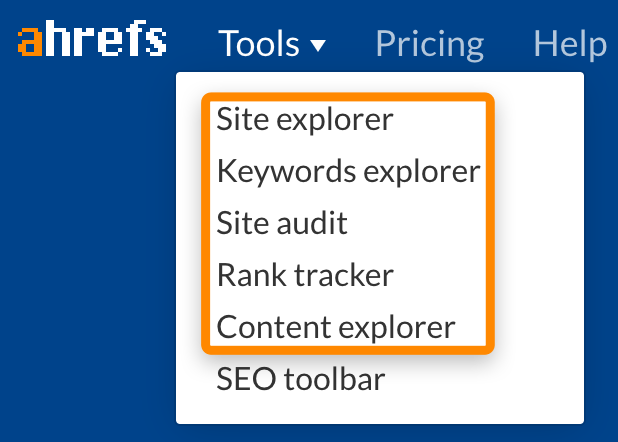
In total, these pages get around 25,000 monthly visits from organic search, and we rank in the top five for all of our main keywords:

But, these pages account for less than 4% of search traffic to our site:

We currently get an estimated 669,000 monthly organic visits to our website, of which traffic to our landing pages accounts for just ~4%.
How? Because we’ve also written hundreds of pieces of SEO content for our blog.
In total, these posts get over 300,000 monthly visits from organic search alone:

If we didn’t do this, we’d be leaving a lot of money on the table because potential customers aren’t always searching for our products directly.
Many are just looking for a solution to a problem that our tools happen to solve.
For example, we have a competitive research tool called Site Explorer. One of the things it does is show who’s linking to any website or web page.
But, potential customers might not know we offer this product and instead search for something like “who links to my website.”
So we decided to write a blog post about that:

Writing “SEO content” like this is important because it brings more potential customers to our site.
Make sense?
Good. Now let’s talk about how to actually write this stuff.
Not all blog posts are SEO content, and pouring your heart and soul into your content doesn’t guarantee rankings and traffic.
Just look at the stats for one of my favorite blog posts:

It’s 7,600 words long, has been shared over 50,000 times, has fantastic illustrations, and is super well-written. It’s a masterpiece.
But look again at how much traffic it gets from search engines:
34. Measly. Visits. A. Month.
So, if you want your post to get organic traffic, you need to write it around a proven SEO framework.
What is that framework? It looks something like this:
- Find a proven topic
- Analyze search intent
- Write an outline
- Write a draft
- Edit your draft
- Make your content visually appealing
- Write a compelling title and description
- Upload your post
Let’s go through each of those steps in more detail.
1. Find a proven topic
Before you even think about putting pen to paper, you need to find a relevant topic with “traffic potential.”
To do this, think about broad topics that your potential customers might be searching for.
If you sell baking supplies online, then this might be recipes for baked goods, cookware reviews, or other things related to baking.
From there, search for those broad topics in Ahrefs’ Keywords Explorer, and then check the “Phrase match” report to see keyword ideas:
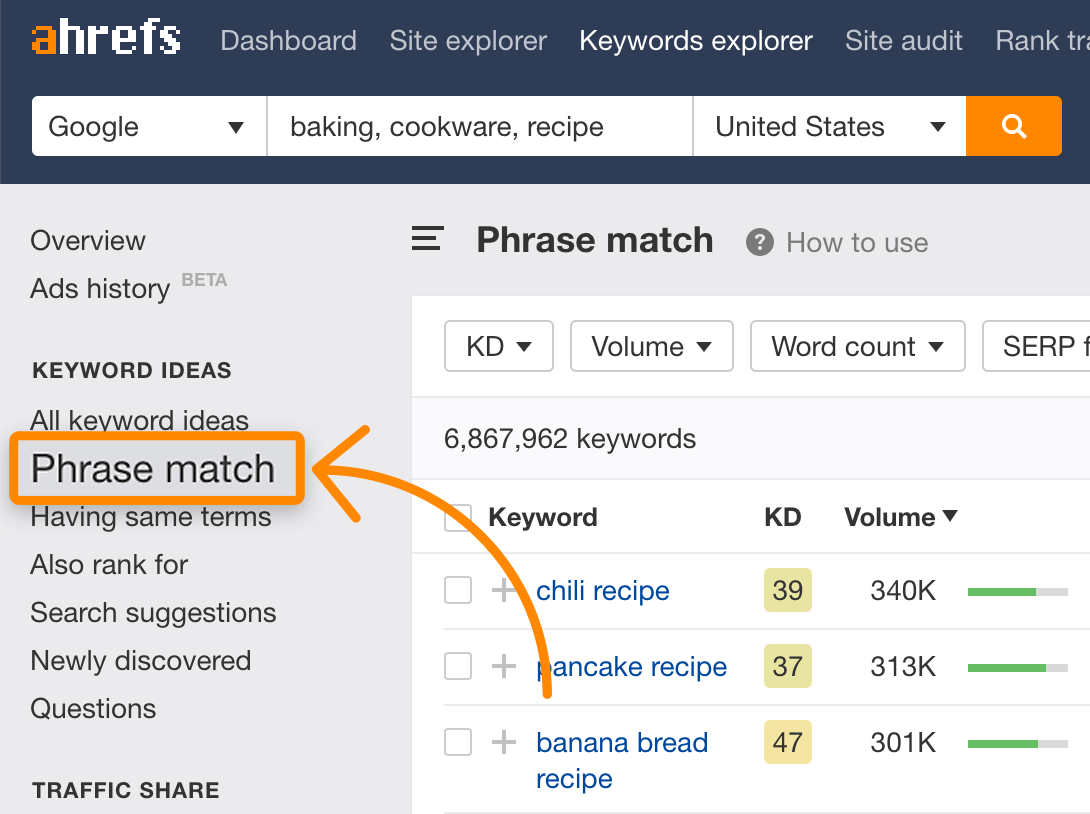
Because this gives us a lot of keyword ideas (almost seven million in this case!), let’s filter out super-competitive competitive keywords and those with little or no search volume.

Right away, we see some good topic ideas like banana bread recipe, apple pie recipe, and pizza dough recipe, each with tons of monthly searches.
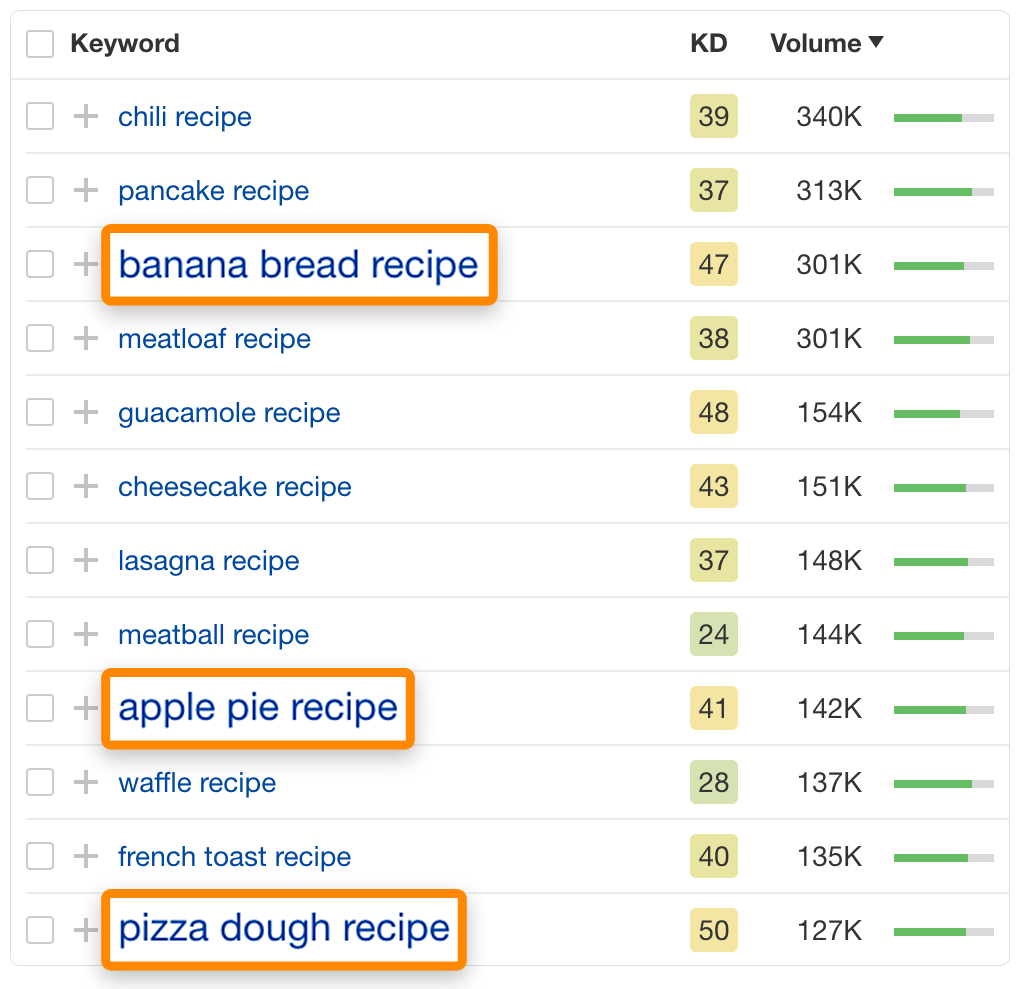
But here’s the thing with search volume: it can be misleading.
For example, take a look at the search volumes for these two keywords:
Because “butter cake recipe” has almost five times more searches than “chocolate chip cookie cake recipe,” you’d expect this topic to have the most traffic potential.
However, if we look at the top-ranking page, we see that it gets an estimated 2,383 US visits a month from organic search….

… whereas the top-ranking page for “chocolate chip cookie cake recipe” gets more:

This happens because the top-ranking page ranks for—and gets traffic from—more queries.
So, before you settle on a topic, always look at the estimated traffic to the top-ranking page to get a better sense of true traffic potential.
2. Analyze search intent
Search engines like Google have invested billions of dollars into understanding the true intent behind searches.
This is how they’re able to return relevant results—even for vague queries.
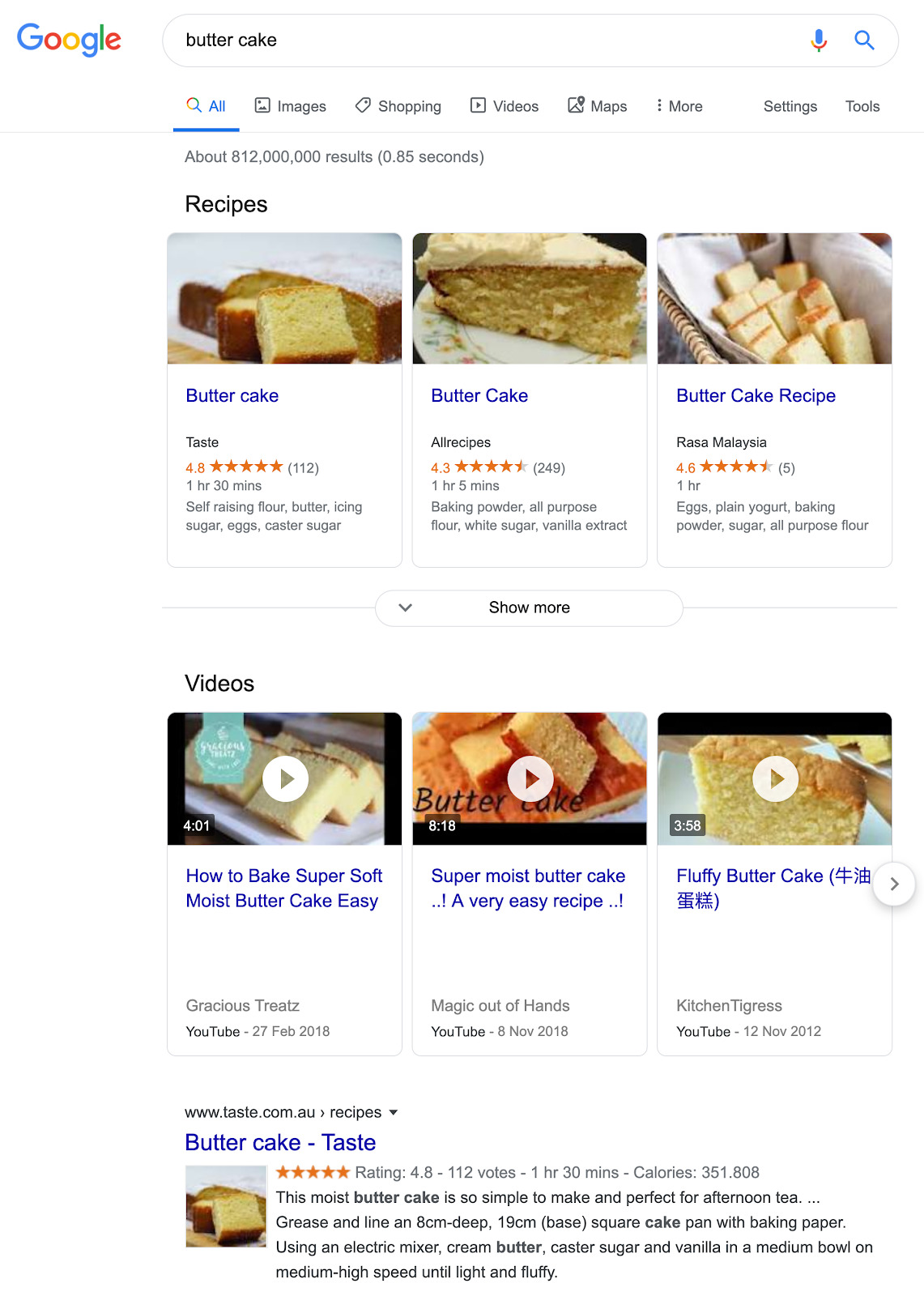
Google knows I’m looking for a recipe, despite not specifying that in the query itself.
If you’re writing SEO content, this is important, because if it doesn’t align with search intent, your chances of ranking are slim to none.
But, how can you figure out search intent?
The answer is to take clues from the top-ranking results by analyzing what we call the three C’s of search intent.
These are:
Content type
Are the top-ranking pages blog posts, product pages, category pages, landing pages, or something else?
If they’re not mostly blog posts, then go back to step one and choose a different topic.
Content format
What type of posts rank? Are they how-to’s, list-style posts, opinion pieces, news articles, something else?
For “best baking pans,” they’re all lists:

Content angle
Look at the page titles to understand more about the type of person searching for this. Are they a beginner or an expert? What do they value? Are they looking for a quick solution or something more in-depth?
For example, many of the pages ranking for “french bread recipe” pitch how easy the recipe is:
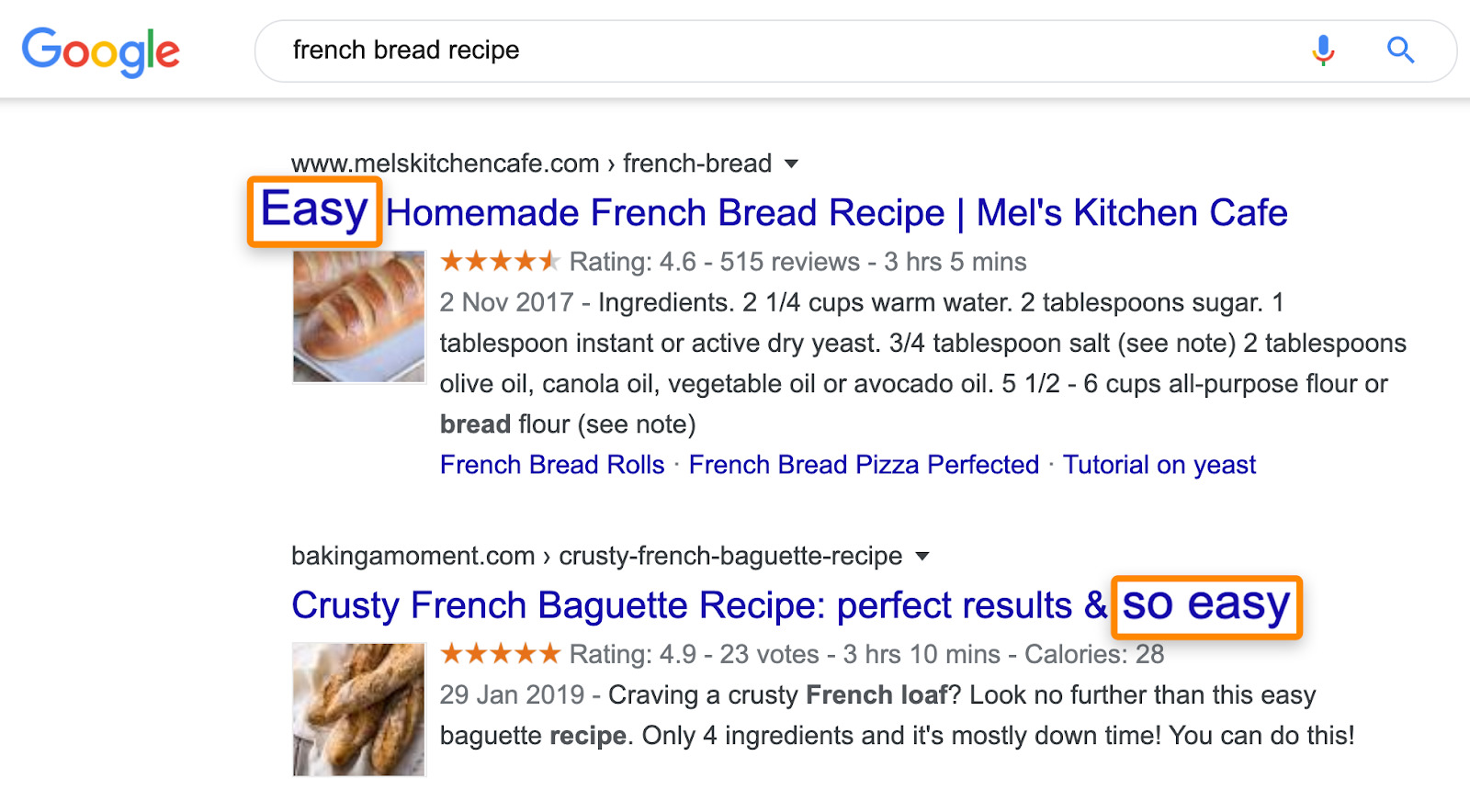
For flat dough bread recipe, speed seems to be what appeals to searchers:
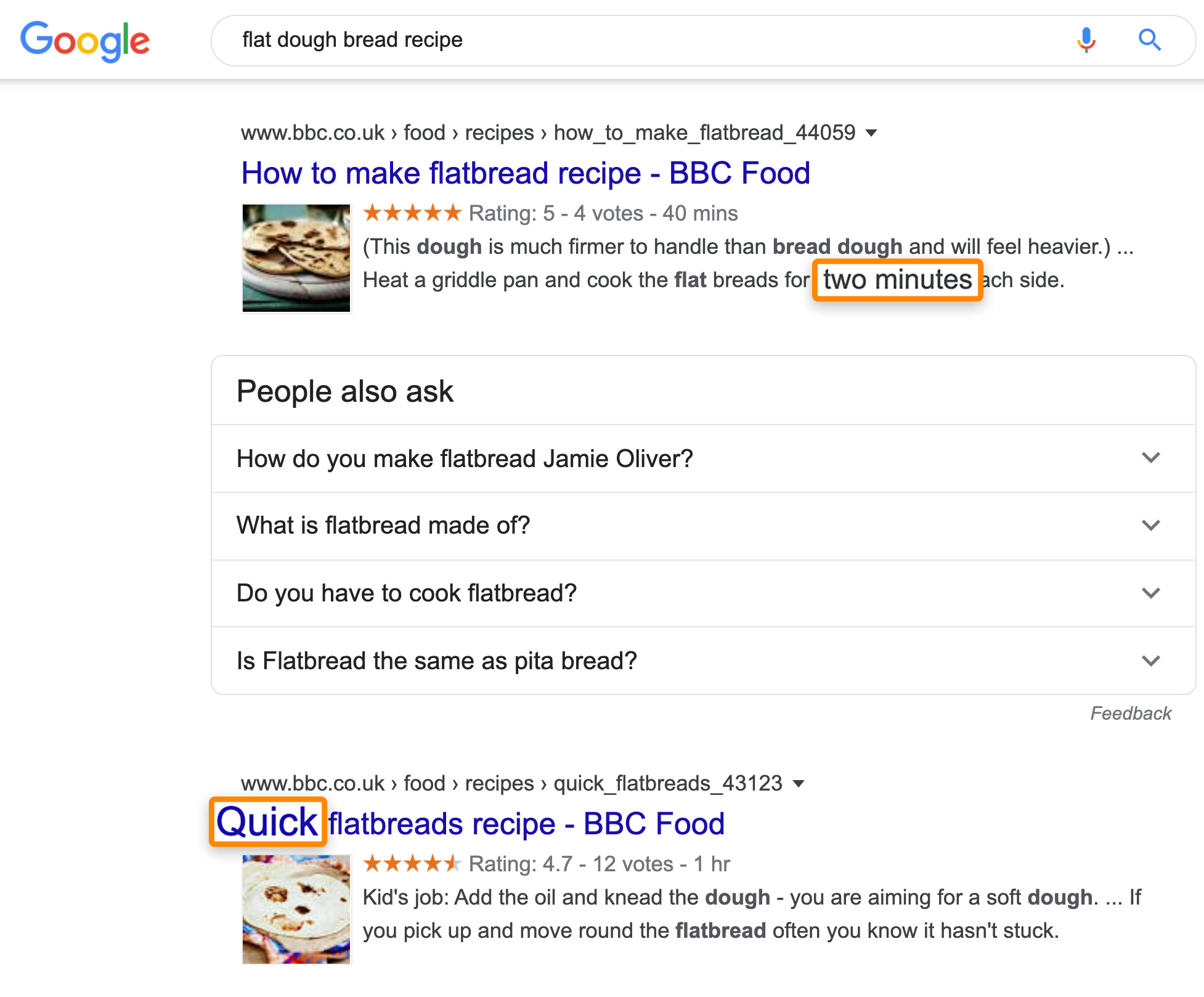
Recommended reading: Search Intent: The Overlooked ‘Ranking Factor’ You Should Be Optimizing for in 2019
3. Write a data-driven outline
The average top-ranking page ranks for nearly 1,000 other relevant keywords in the top 10.
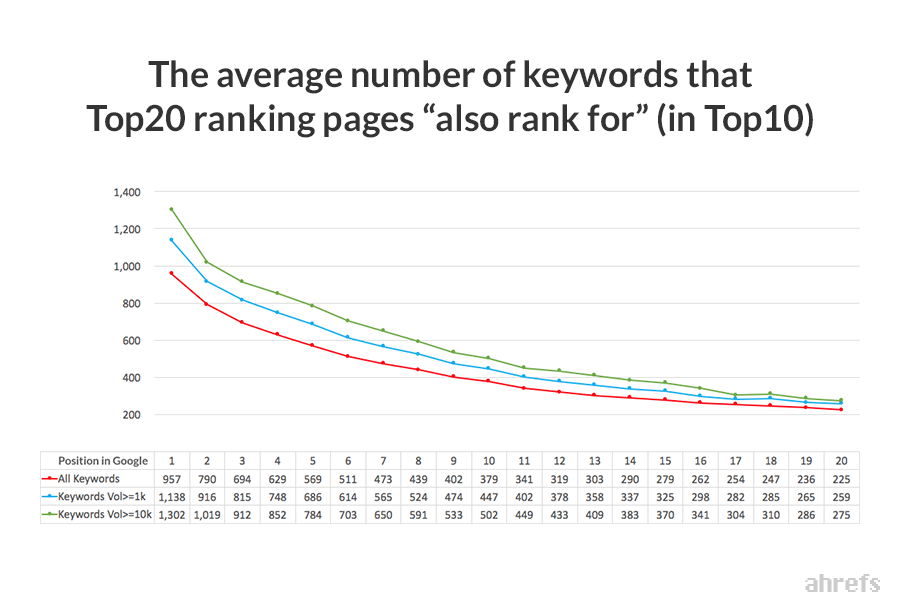
For that reason, it pays to know which other keywords the top-ranking pages also rank for when creating your outline—so you can rank for them too.
How can you find them?
Paste the URL of the top-ranking page into Ahrefs’ Site Explorer, then go to the Organic keywords report. To weed out irrelevant keywords, filter for keywords where the page ranks in position ten or higher.

You’ll probably notice that many of these are synonyms or less popular ways to search for much the same thing, but some should give you insight into what searchers want to see from this page.
For example, we see that the top-ranking page for “flatbread dough recipe” also ranks for things like “no yeast flatbread,” “quick flatbread pizza recipe,” “homemade flatbread”:

Note that you shouldn’t stuff these words and phrases into your post, but instead use them to iron out the angle of your content and create a rough outline.
For example, if we were writing a flatbread dough recipe, we’d probably want to mention speed in the intro, and we might want to have separate sections on making the flatbread with and without yeast.
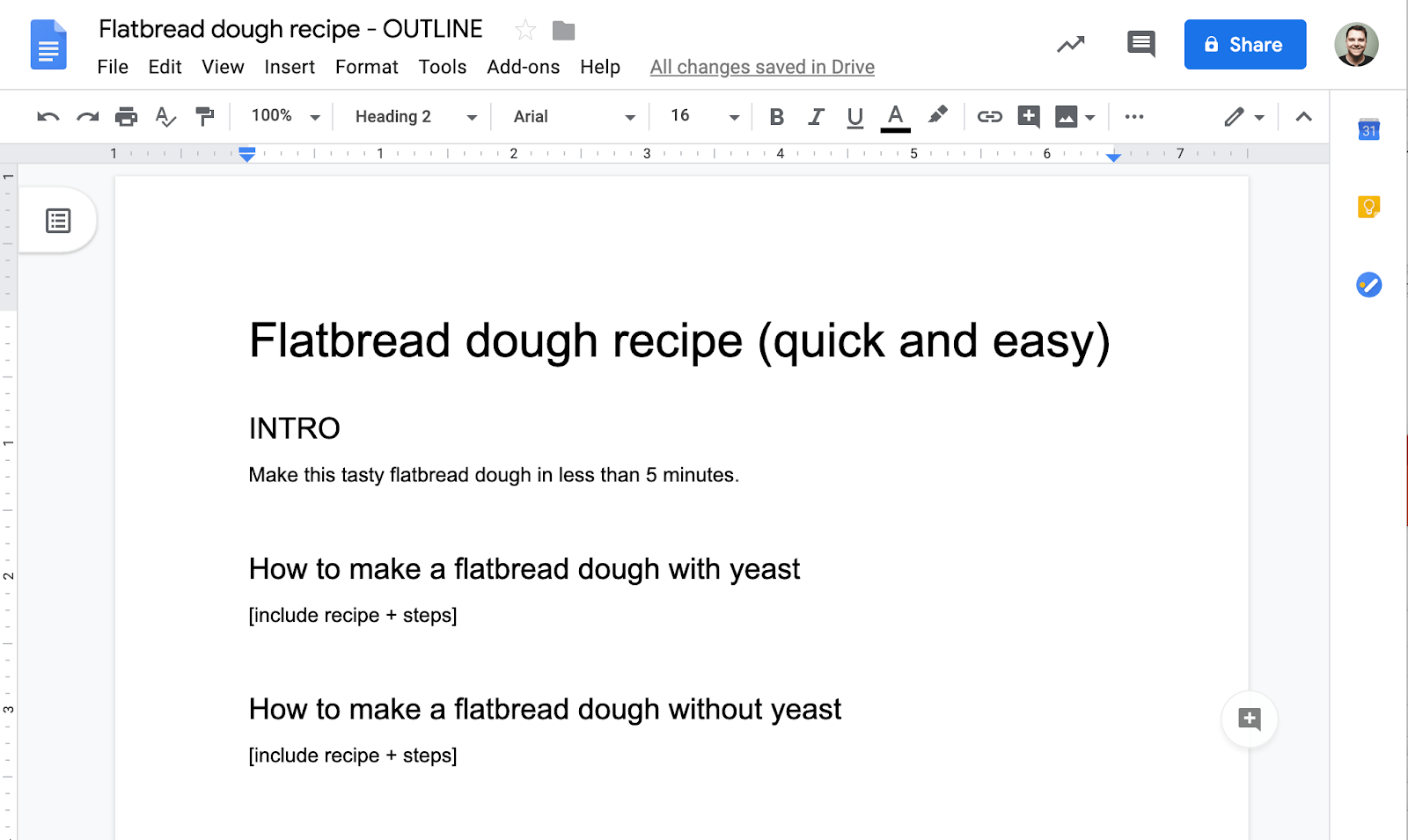
If you don’t use Ahrefs, then you can do the same thing by looking at the top-ranking pages and using some common sense.
4. Write a draft
Good news: It’s finally time to put pen to paper and draft your post.
Because this doesn’t have much to do with SEO, we won’t dwell on this process too much. Just remember that the aim here isn’t to write a perfect draft right off the bat, but rather to turn your thoughts into something tangible to work with.

Here are a couple of tips for doing this as quickly as possible:
Write as you speak
Most of the best blog posts are written in an informal, conversational tone, so there’s no need to agonize over every word. Just write as you speak.
Don’t worry if it sounds silly; you can correct this in the next step.
Use the Pomodoro technique
The Pomodoro technique is simple: you set a 25-minute timer, and a goal you want to achieve in that time.
For drafting blog posts, a good goal is a certain number of words.
Most people type at around 40 words per minute, so that’s 1,000 words in 25 minutes. However, drafting a blog post is more mentally taxing than just typing, so let’s assume 30–40% efficiency, or 300–400 words every 25 minutes.
Take a short break after 25 minutes, then repeat.
Continue this process until you have a complete draft.
Sidenote.
Test your typing speed here. That way, you can set a more custom goal.
5. Edit your draft
Pulling readers into the flow of your content is important if you want them to stick around—which you do.
Not only is this good for conversions (which is ultimately the point of ranking), but it also has a positive impact on user engagement metrics like time on page, dwell time, and bounce rate, which some SEOs believe may indirectly influence rankings.
Here are three things to focus on:
Correct spelling and grammatical errors
Most word processors and writing apps have spell check built-in, so you don’t have to be a genius to get things right. Just right-click and choose the right spelling.

For grammar, run your draft through a tool called Grammarly. This will tell you about misplaced commas and sentences that don’t make sense.

Make sure it flows
If your content sounds unnatural or robotic, now is the time to rephrase.
Keep it simple
Most Americans read below an eighth-grade reading level. If you’re using complex sentences and words, that’s going to confuse readers, and they won’t hesitate to hit the back button.
Solve this by running your draft through Hemingway.
This is a free browser-based tool that helps you simplify your content using more straightforward sentences, paragraphs, and words.

Get feedback
Sure, it’s soul-crushing to hear that your content isn’t quite up to scratch. But the truth is that the opinion of others can help improve things exponentially.
Send your draft to a friend, tell them to be honest, iron out any creases.
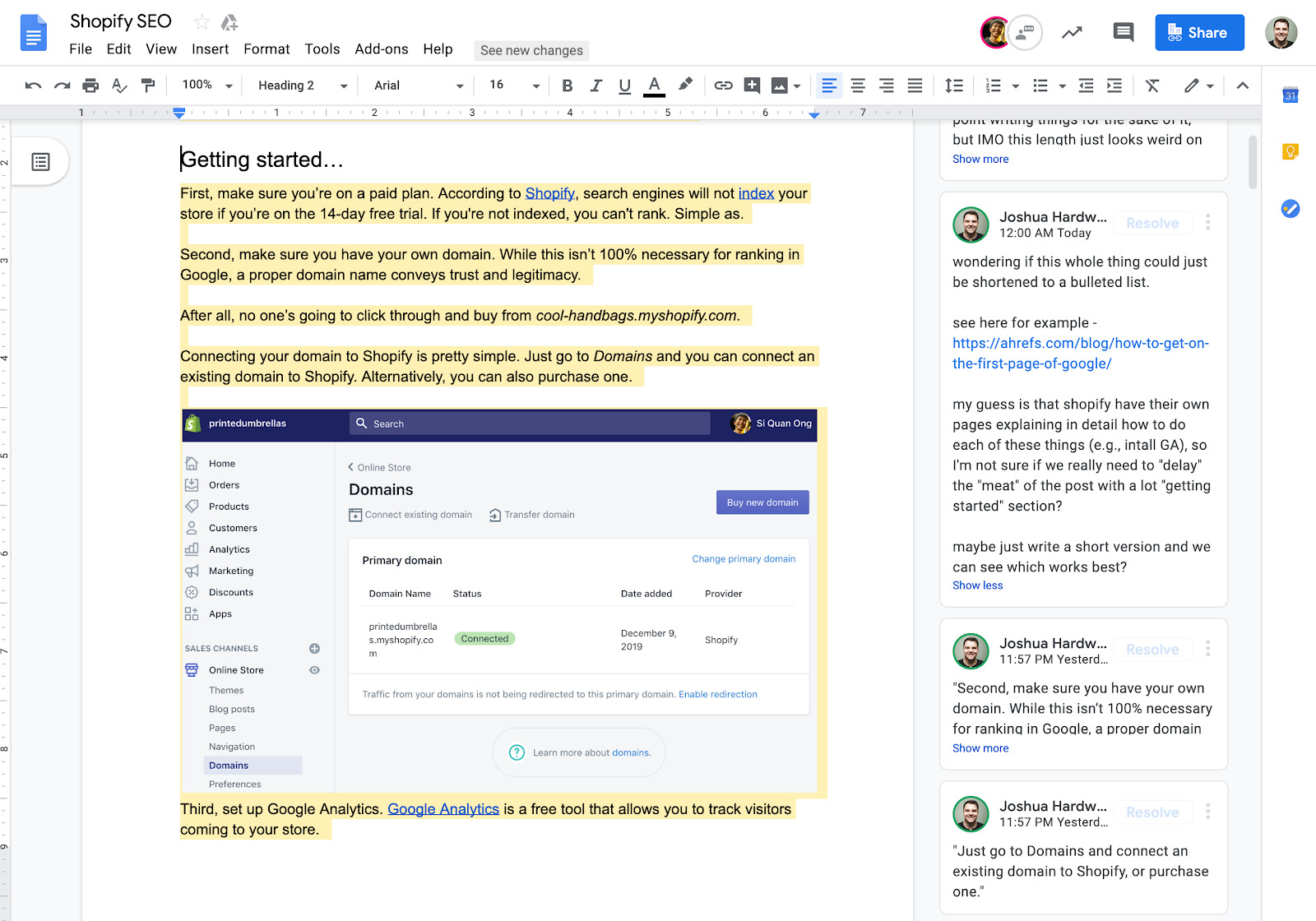
6. Make your content visually appealing
Nobody likes reading a wall of text. If you’ve written more than a few sentences, then you should work to break up the copy.
The most obvious way to do this is with images.
They don’t have to be anything special. You’ll notice that a lot of our posts on the Ahrefs Blog include annotated screenshots like this one:
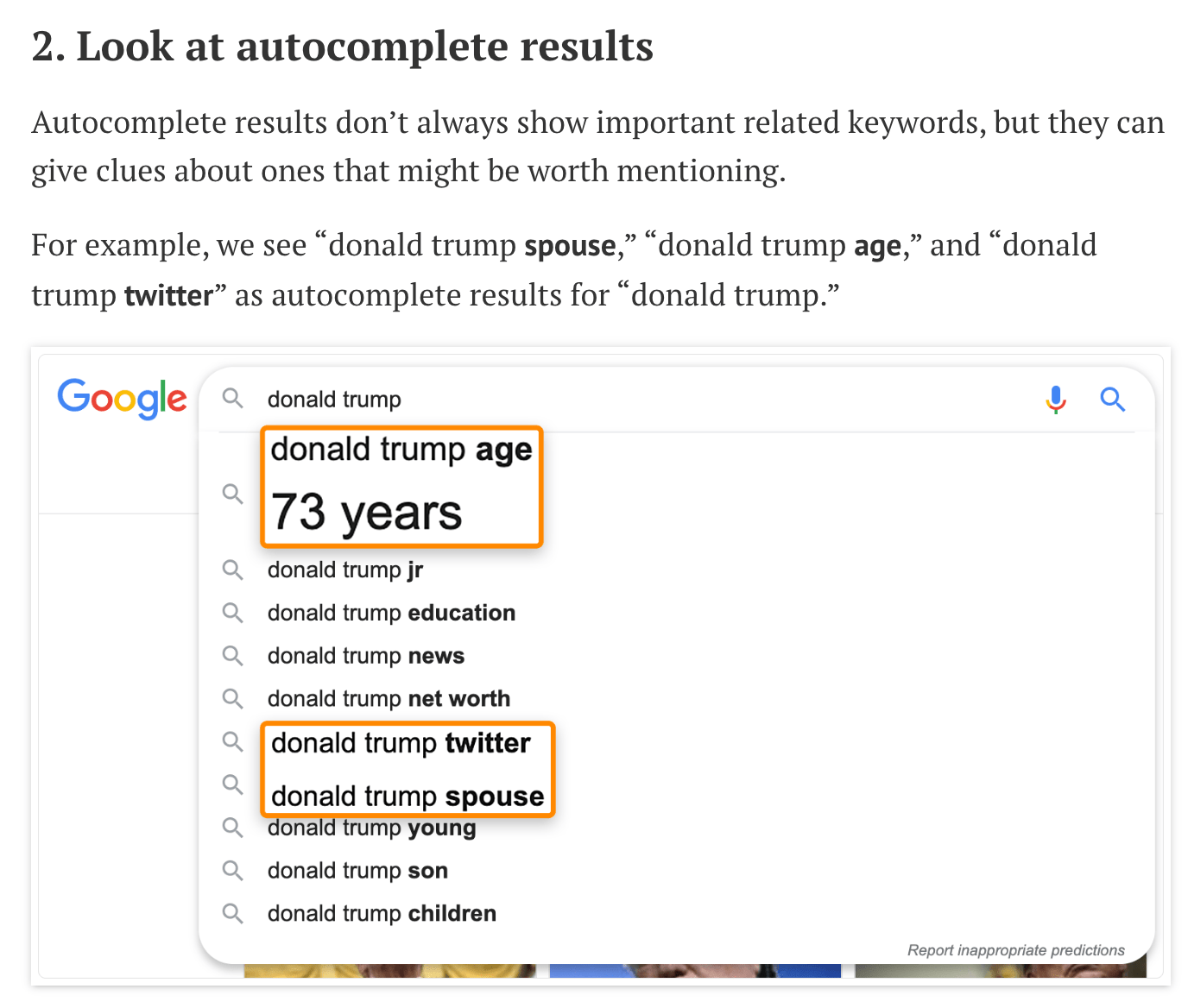
A screenshot from one of our blog posts.
Not only does this make things easier to skim, but it also helps to demonstrate what we’re trying to explain.
You can also use videos to do this:
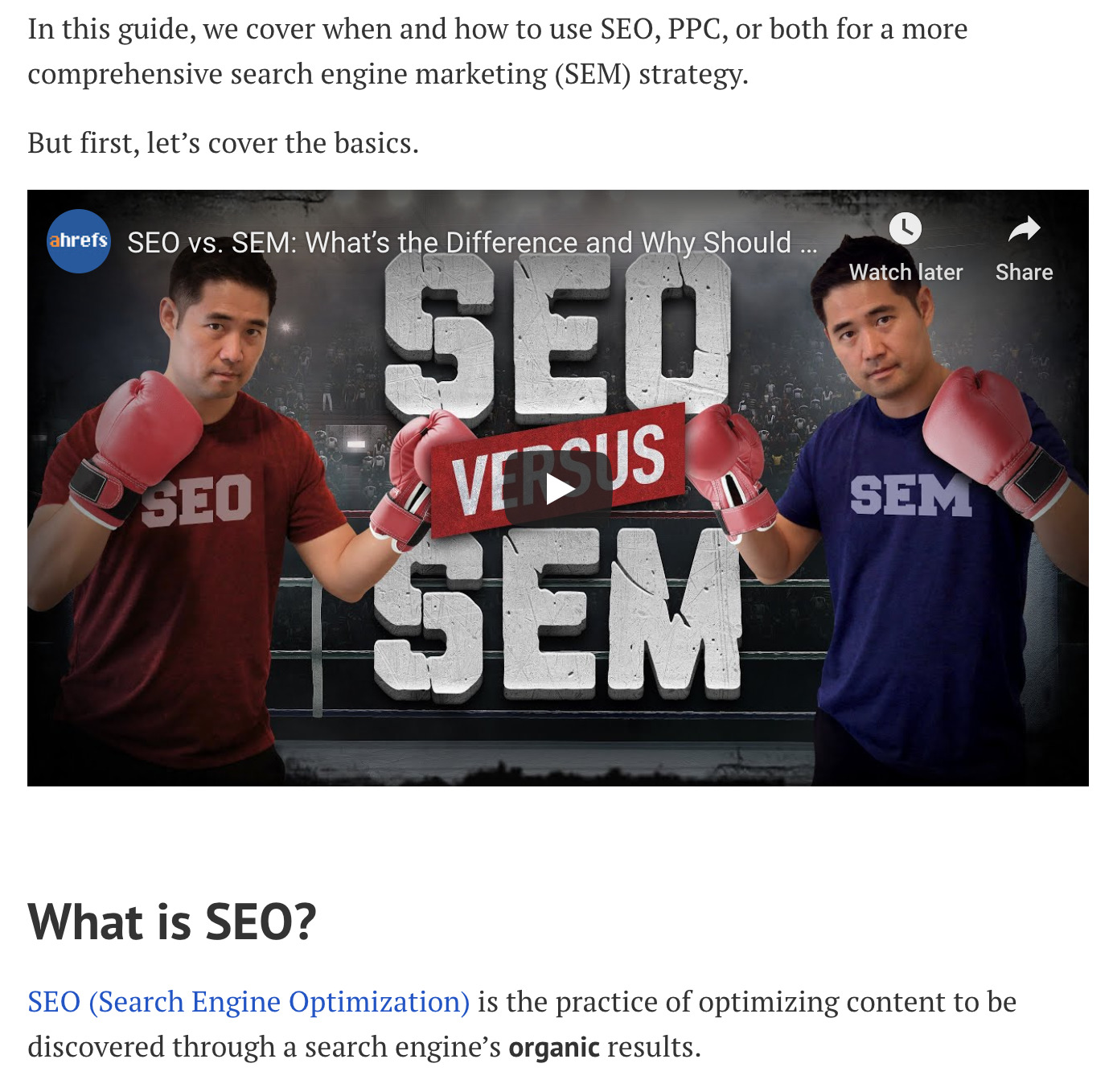
A video embedded in one of our blog posts.
Many studies show that visuals help people understand and comprehend content, so including useful images and videos can improve user satisfaction—which we know is important to Google.
Including images and videos can also help your content rank in Google’s image and video tabs.
Don’t overlook this. We’ve had over 5,500 visits from Google Images in the past three months…
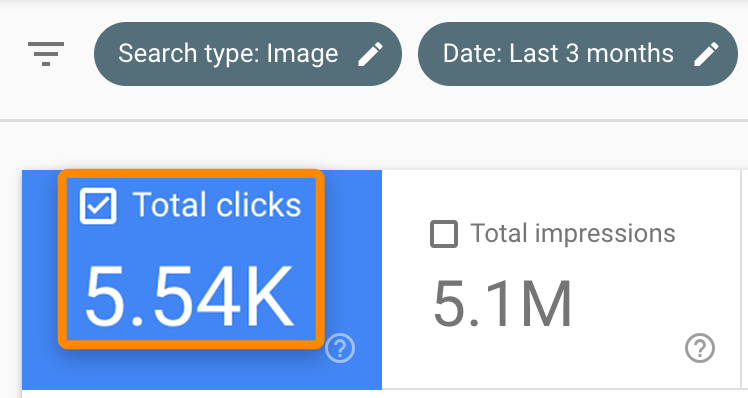
… and 32,000 from video results:

But images and videos don’t always make sense. So another thing you can do is break lengthy chunks of text into subsections using H2-H6 headers.
7. Write a compelling meta title and description
Search engines see more than just the text on the page. They look at metadata in the page’s code to learn more about your content.
The two more important pieces of metadata are your meta title and description. Both of these show up in Google’s search results, and they’re effectively your sales pitch to searchers. Use them to explain why they should click and read your post.

Sidenote.
Google sometimes rewrites these two things, so what you set isn’t always what shows up in the SERP. But it’s still best to set them.
This is another place it’s useful to match search intent.
Whatever searchers value, pitch it in your title tag. Just make sure it’s still an accurate description of your content. Do the same with your meta description.
This will entice more clicks on your page in the search results, which leads to more traffic.
Some SEOs believe that clickthrough rate also impacts rankings, but Google says this isn’t the case because the metric is too noisy.
Either way. SEO is not just about rankings, but also getting clicks from searchers.
8. Upload your post
Nothing to do with SEO, but here’s a tip to save you some serious time if you use WordPress: Write your content in Google Docs and upload it with Wordable.
It takes just one click to send your content—complete with images—to WordPress. It’s ready for publishing in seconds.
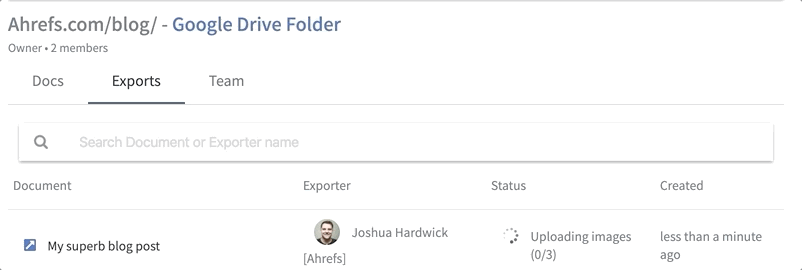
This is what we use to upload every post to the Ahrefs Blog.
Google tells us that the two most important ranking factors are content and links.
https://www.youtube.com/watch?v=l8VnZCcl9J4&feature=youtu.be&t=1820
So, while creating perfectly optimized content is often enough to rank for less competitive topics, links are still important for those harder topics that a lot of brands want to rank for.
But here’s the thing: content and links are somewhat intertwined.
In other words, nobody wants to link to poor or mediocre content; they link to content that’s valuable for their visitors.
While link building is a separate—and complex—topic of its own, there are ways to use your content to improve your ability to win links.
1. Make it the go-to resource on a topic
Pull this off, and people are more likely to link to your guide over others.
We did this with our guide to Google search operators, which has attracted backlinks from over 560 websites:

2. Include unique data
Having unique data means people have to cite you as the source when quoting that data.
This is why our studies usually get tons of links:
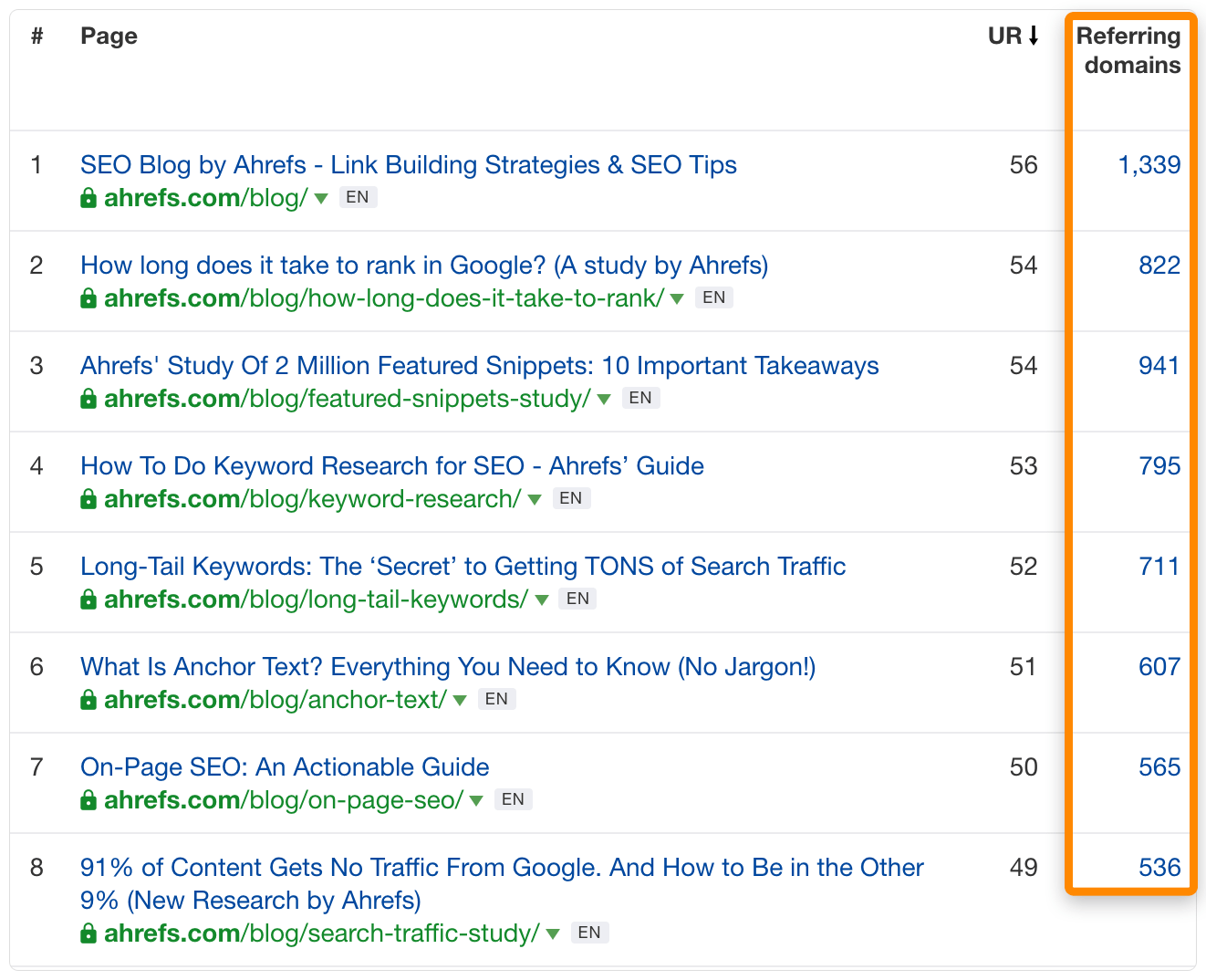
3. Make it as accessible as possible
People aren’t going to link to something they find confusing or difficult to read. (This is another reason why step #6 is so important).
Final thoughts
Following a proven SEO framework to write content makes sense, and it certainly improves your chances of ranking. But it’s important to remember that things don’t always work out, even if you do everything “right.”
Just look at traffic to our post on influencer marketing:

It’s a proven topic, the post aligns with search intent, and it covers the topic comprehensively… yet it doesn’t even rank in the top 100.
If this happens, it’s not the end of the world. Just rewrite and republish the content and try again.
We did this with our guide to driving more traffic to your website, and traffic and rankings went through the roof:

You can also rewrite content when traffic starts to drop.
This is what we did with our list of top Google searches:
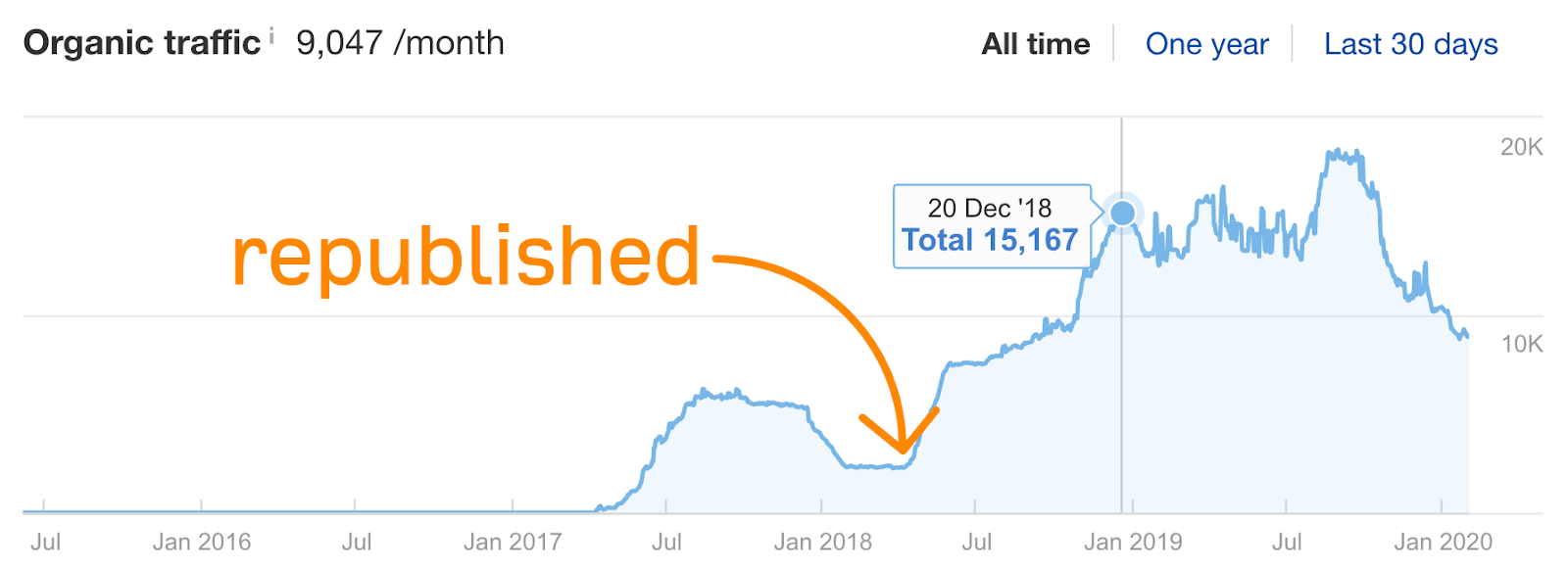
Did we miss anything important in this guide? Give me a shout on Twitter.
